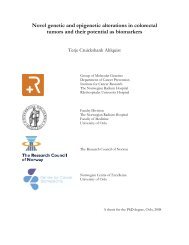Preface - Ous-research.no
Preface - Ous-research.no
Preface - Ous-research.no
You also want an ePaper? Increase the reach of your titles
YUMPU automatically turns print PDFs into web optimized ePapers that Google loves.
Integrated Cardiovascular Function<br />
Leader:<br />
Otto A. Smiseth, Professor, MD, PhD, (OUH/UiO)<br />
Deputy Leader:<br />
Thor Edvardsen, Professor, M.D., Ph.D., (OUH/UiO)<br />
Scientific staff:<br />
Espen Remme, PhD, Postdoctoral Fellow (SENRHA / OUH)<br />
Helge Skulstad, MD, PhD Senior Researcher (OUH)<br />
Kristina H Haugaa, MD, PhD, Postdoctoral Fellow (SENRHA)<br />
Ola Gjesdal, MD, PhD, Postdoctoral Fellow (NRC)<br />
Thomas Helle-Valle, MD, PhD-student (NCCD)<br />
Trond Vartdal, MD, PhD-student (NCCD)<br />
Anders Opdahl, MD, PhD-student (NCCD)<br />
Marit Kristine Smedsrud, MD, PhD-student (NRC)<br />
Kristoffer Russell, MD, PhD-student (UIO)<br />
Sebastian Imre Sarvari, MD, PhD-student (FP 7, EU)<br />
Espen Bøe, MD, PhD-student (NCCD)<br />
General objectives:<br />
The Integrated Cardiovascular Function group studies<br />
cardiac mechanics in experimental studies and studies in<br />
patients. The idea is to develop better diag<strong>no</strong>stic understanding<br />
and solutions into clinical practice.<br />
Specific objectives:<br />
1) To investigate mechanisms of LV dyssynchrony and<br />
develop better methods for selecting patients for cardiac<br />
resynchronization therapy.<br />
2) To investigate LV mechanical-electrical interactions and<br />
improve risk stratification for ventricular arrhythmias.<br />
3) To investigate mechanisms of LV (left ventricular) diastolic<br />
dysfunction.<br />
4) To develop better diag<strong>no</strong>stic methods to identify viable<br />
myocardium<br />
5) To investigate hemodynamic effects of Cardiac resynchronization<br />
therapy (CRP) in patients with heart failure and<br />
narrow QRS.<br />
6) To develop better diag<strong>no</strong>stic tools to identify optimal<br />
timing of surgery in valvular heart disease.<br />
1. LV dyssynchrony: Cardiac resynchronisation therapy (CRT)<br />
has been documented to be a powerful treatment in patients<br />
with severe congestive heart failure, causing reverse LV<br />
Professor Otto A. Smiseth<br />
remodelling, improvement of symptoms and reduction of<br />
mortality (Cleland 2005). In left bundle branch block (LBBB)<br />
the LV wall contraction is dyssynchro<strong>no</strong>us due to electrical<br />
conduction delay to the free LV wall, and CRT resynchronizes<br />
the contractions by bi-ventricular pacing and thereby<br />
improves the contractile function. Currently, patients are<br />
selected for CRT on basis of the presence of wide QRS in the<br />
ECG. However, in about 30 % of these patients, there is <strong>no</strong><br />
improvement in symptoms, and in some cases aggravation<br />
of symptoms by CRT (Jarcho, 2006). The high number of<br />
<strong>no</strong>n-responders represents a major problem with CRT, and<br />
better criteria for selection of candidates for this treatment<br />
modality are therefore needed.<br />
Because ECG has limited ability to identify candidates<br />
for CRT, echocardiography with tissue Doppler imaging<br />
has been proposed as a more sensitive and more specific<br />
method to identify dyssynchrony. However, so far echocardiography<br />
has <strong>no</strong> proven clinical value in selection of candidates<br />
for bi-ventricular pacing. We suggest that a better<br />
understanding of the underlying mechanism of dyssynchrony<br />
is important to interpret the echocardiographic findings,<br />
and thereby to improve patient-selection for CRT. To achieve<br />
this we have investigated mechanisms of dyssynchrony and<br />
have established a new method to differentiate between<br />
mechanical and electrical etiologies of dyssynchrony.<br />
In LBBB, the pathological motion of the inter-ventricular<br />
septum during early systole has been proposed as a good<br />
predictor of response to CRT. The mechanisms responsible<br />
for this motion are, however, poorly understood. We challenge<br />
existing theories on the timing of active contraction<br />
in the septum, and have proven that the early-systolic<br />
ab<strong>no</strong>rmal septal motion is due to active contraction and <strong>no</strong>t<br />
merely a passive consequence of pressure differences across<br />
the septum. This phase has <strong>no</strong>t previously been considered<br />
active when assessing dyssynchrony, and this might explain<br />
the failure of most echocardiographic indices of dyssynchrony<br />
to predict CRT-response.<br />
19
















